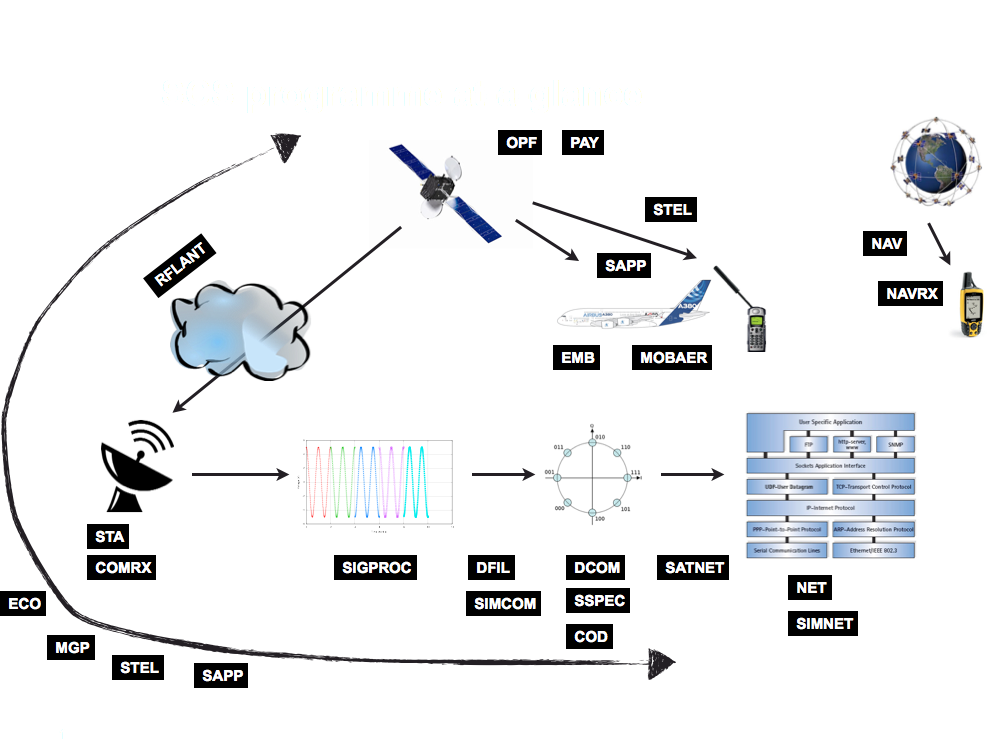The programme favours a system approach to satellite communications and navigation so to be able to taking into account all relevent parameters during the design of such systems. All courses are delivered in English.
Information about how to apply is available here.
The year is organized in a teaching semester (September to March) and internship semester (April to September).
The teaching semester (September to March)
Teaching modules are dispatched over 3 categories: (1) core satcom techniques, (2) space systems building blocks and (3) space services & applications. The following table lists the different modules.
| Core satcom techniques | Space systems building blocks |
|---|---|
| Signal processing (SIGPROG) | Orbits & satellite platforms (OPF) |
| Digital ccommunications (DCOM) | Antennas, propagation & RF links (RFLANT) |
| Spread spectrum techniques (SSPEC) | Space communications systems (STEL) |
| Coding applied to the satellite channel (COD) | Satellite based navigation & localisation systems (NAV) |
| Network & telecommunications protocols (NET) | Payloads (PAY) |
| Simulation of networks (SIMNET) | Digital filters (DFIL) |
| Simulation of communication systems (SIMCOM) | Digital navigation receivers (NAVRX) |
| Project 1 - first part (PROJ1-1) | Digital communication receivers (COMRX) |
| Earth stations and terminals (STA) | |
| Project 2 - system design & dimensioning (PROJ2) |
| Space services & applications |
|---|
| Satellite based computer networks (SATNET) |
| Embedded systems (EMB) |
| Satellite-based mobile & aeronautical communications (MOBAER) |
| Economical & legal aspects (ECO) |
| Overview of satellite applications (SAPP) |
| Project management (MGP) |
| Project 1 - second part (PROJ1-2) |
Each module as listed above includes lectures, seminars and workshops. We have also 2 projects where students are grouped in teams. Each team is assigned a different topic under the supervision of an academics or one of our partners from the Industry. Project 1 is a large project spanning over the entire course duration.
Summarizing how modules relate to each other from a system perspective, we get this:

The internship semester (April to September)
The internship is place 6-month placement in a company, agency or research centre. The placement takes place in France or abroad. During the placement you receive a salary as a trainee. We receive every years tens of internship offers from (the list is not exhaustive): CNES, DLR (the German Aerospace Centre), EADS Airbus, EADS Astrium, M3 systems, ONERA, SAFRAN, SOGETI, Thales and Thales Alenia Space, Triagnosys. Enough for our students to make their selection according to their career plan.
The teaching staff
The teaching staff encompasses academics and personnel from agencies and the Industry. Here is a list of the institutions participating to the teaching programme:
- CNES (the French Space Agency)
- EADS Astrium Satellites
- EADS Astrium Services
- ENAC (French Civil Aviation School)
- ESA
- Euroconsult
- Euryece Telecom
- Eutelsat
- Inmarsat
- INPT-ENSEEIHT
- ISAE
- ONERA
- SatConsult
- SES Astra
- Télécom Bretagne
- Thales Alenia Space
- Zodiac Aerospace
A commitment to quality
In order to keep a high-quality training, we are regularly seeking feedback from our students and Industry partners. Every year, two surveys are conducted within the students: one at mid-term (December) and one at the end of the teaching semester. Our schools (INPT-ENSEEIHT, ISAE and Télécom Bretagne) also include a special body in their organization. This body is contributed by professionals from the Industry with a dedicated role to screen the teaching programmes and deliver advices on possible ways of improvement.